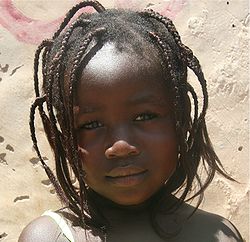- Demographics of Burkina Faso
-
This article is about the demographic features of the population of Burkina Faso, including population density, ethnicity, education level, health of the populace, economic status, religious affiliations and other aspects of the population.
 Demographics of Burkina Faso, Data of FAO, year 2005 ; Number of inhabitants in thousands.
Demographics of Burkina Faso, Data of FAO, year 2005 ; Number of inhabitants in thousands.
Burkina Faso's 15,3 million people belong to two major West African cultural groups—the Gur (Voltaic) and the Mandé. The Voltaic are far more numerous and include the Mossi, who make up about one-half of the population. The Mossi claim descent from warriors who migrated to present-day Burkina Faso and established an empire that lasted more than 800 years. Predominantly farmers, the Mossi are still bound by the traditions of the Mogho Naba, who hold court in Ouagadougou.
About 12,000 Europeans reside in Burkina Faso, the majority are French.
Most of Burkina's people are concentrated in the south and center of the country, sometimes exceeding 48 per square kilometer (125/sq. mi.). This population density, high for Africa, causes annual migrations of hundreds of thousands of Burkinabé to Côte d'Ivoire and Ghana for seasonal agricultural work. About a third of Burkinabé adhere to traditional African religions. The introduction of Islam to Burkina Faso was initially resisted by the Mossi rulers. Christians, predominantly Roman Catholics, are largely concentrated among the urban elite.
Few Burkinabé have had formal education. Schooling is free but not compulsory, and only about 29% of Burkina's primary school-age children receive a basic education. The University of Ouagadougou, founded in 1974, was the country's first institution of higher education. The Polytechnic University of Bobo-Dioulasso in Bobo-Dioulasso was opened in 1995.
 Bobo men in Bobo-Dioulasso
Bobo men in Bobo-Dioulasso
CIA World Factbook demographic statistics
The following demographic statistics are from the CIA World Factbook, unless otherwise indicated.
Population
- 15,746,232 (July 2009 est.)
- Note: estimates for this country explicitly take into account the effects of excess mortality due to AIDS; this can result in lower life expectancy, higher infant mortality and death rates, lower population and growth rates, and changes in the distribution of population by age and sex than would otherwise be expected
Age structure
- 0-14 years: 46.8% (male 3,267,202/female 3,235,190)
- 15-64 years: 50.7% (male 3,513,559/female 3,538,623)
- 65 years and over: 2.5% (male 140,083/female 208,315) (2006 est.)
Median age
- Total: 16.8 years
- Male: 16.6 years
- Female: 17 years (2009 est.)
Population growth rate
- 3.103% (2009 est.)
Birth rate
- 44.33 births/1,000 population (2009 est.)
Death rate
- 13.3 deaths/1,000 population (2009 est.)
Net migration rate
- 0 migrant(s)/1,000 population (2006 est.)
Sex ratio
- At birth: 1.03 male(s)/female
- Under 15 years: 1.01 male(s)/female
- 15-64 years: 0.99 male(s)/female
- 65 years and over: 0.65 male(s)/female
- Total population: 0.99 male(s)/female (2009 est.)
Infant mortality rate
- Total: 91.35 deaths/1,000 live births
- Male: 99yhths/1,000 live births
- Female: 83.3 deaths/1,000 live births (2006 est.)
Life expectancy at birth
- Total population: 52.95 years
- Male: 51.04 years
- Female: 54.91 years (2009 est.)
Total fertility rate
- 6.14 children born/woman (2011 est.)
HIV/AIDS
- Adult prevalence rate: 1.6% (2007 est.)
- People living with HIV/AIDS: 130,000 (2007 est.)
- Deaths: 9,200 (2007 est.)
Major infectious diseases
- Degree of risk: very high
- Food or waterborne diseases: bacterial and protozoal diarrhea, hepatitis A, and typhoid fever
- Vectorborne disease: malaria and yellow fever
- Water contact disease: schistosomiasis
- Respiratory disease: meningococcal meningitis
- Animal contact diseases: rabies (2009)
Nationality
- Noun: Burkinabé (singular and plural)
- Adjective: Burkinabé
Ethnic groups
Religions
Main article: Religion in Burkina FasoLanguages
- French (official), native African languages (spoken by 90% of the population) including: More, Dioula, Gurma, Senufo
Literacy
- Definition: age 15 and over can read and write
- Total population: 21.8%
- Male: 29.4%
- Female: 15.2% (2003 est.)
Education expenditure
- 4.2% of GDP (2006)
References
 This article incorporates public domain material from the CIA World Factbook document "2009 edition".
This article incorporates public domain material from the CIA World Factbook document "2009 edition".Demographics of Africa Sovereign
states- Algeria
- Angola
- Benin
- Botswana
- Burkina Faso
- Burundi
- Cameroon
- Cape Verde
- Central African Republic
- Chad
- Comoros
- Democratic Republic of the Congo
- Republic of the Congo
- Côte d'Ivoire (Ivory Coast)
- Djibouti
- Egypt
- Equatorial Guinea
- Eritrea
- Ethiopia
- Gabon
- The Gambia
- Ghana
- Guinea
- Guinea-Bissau
- Kenya
- Lesotho
- Liberia
- Libya
- Madagascar
- Malawi
- Mali
- Mauritania
- Mauritius
- Morocco
- Mozambique
- Namibia
- Niger
- Nigeria
- Rwanda
- São Tomé and Príncipe
- Senegal
- Seychelles
- Sierra Leone
- Somalia
- South Africa
- South Sudan
- Sudan
- Swaziland
- Tanzania
- Togo
- Tunisia
- Uganda
- Zambia
- Zimbabwe
States with limited
recognition- Sahrawi Arab Democratic Republic
- Somaliland
Dependencies and
other territories- Canary Islands / Ceuta / Melilla / Plazas de soberanía (Spain)
- Madeira (Portugal)
- Mayotte / Réunion (France)
- Saint Helena / Ascension Island / Tristan da Cunha (United Kingdom)
- Western Sahara
 Burkina Faso topics
Burkina Faso topicsHistory Geography Politics President · Prime Minister · Government · Political parties · Elections · Constitution · Foreign relations · Military · Law enforcement · Human rights (LGBT rights)Economy Agriculture · Energy · Tourism · West African CFA franc · Communications · Companies · Mining · Transport · Trade unions · HealthDemographics Culture Portal Categories:- Burkinabé society
- Demographics by country
Wikimedia Foundation. 2010.


